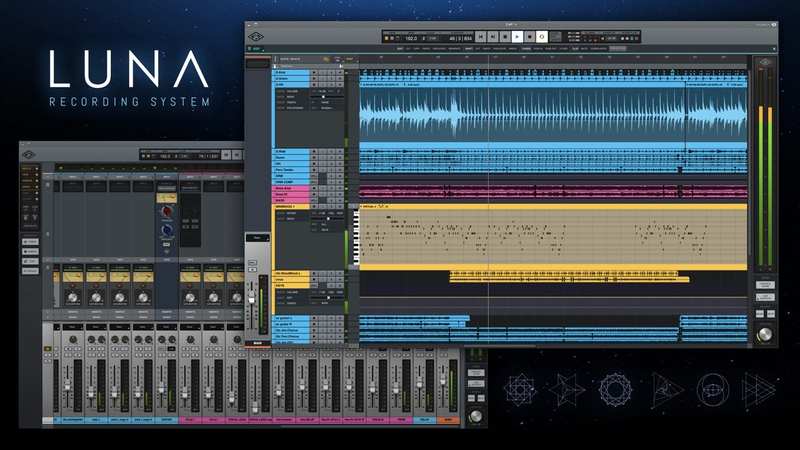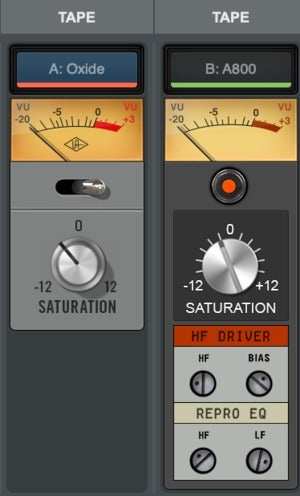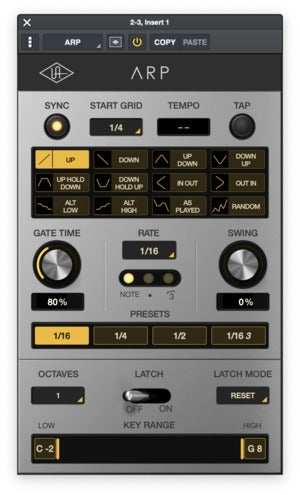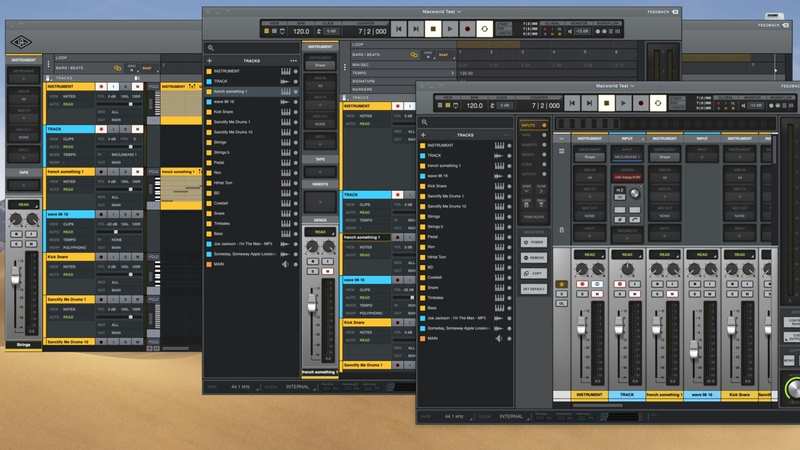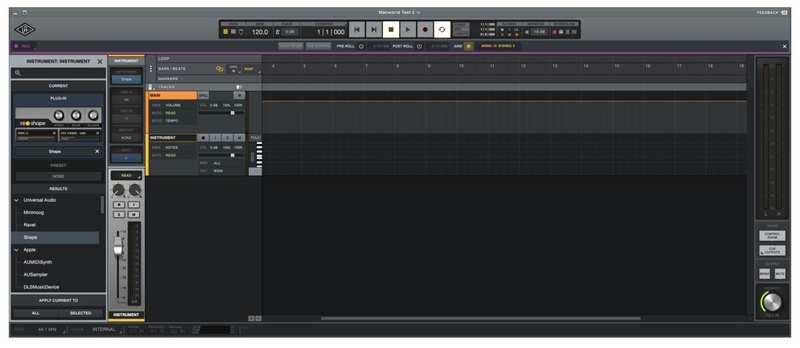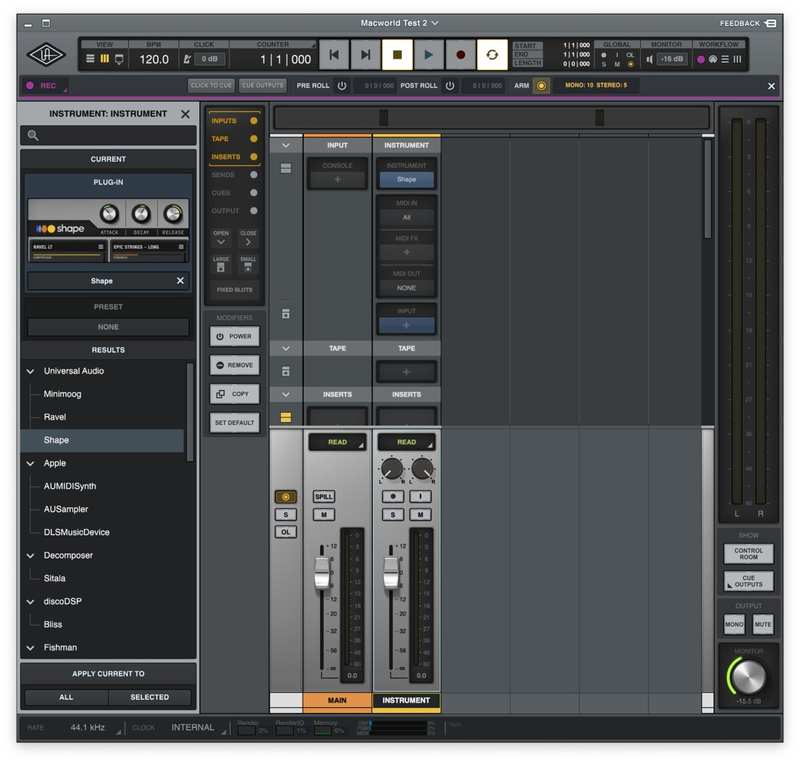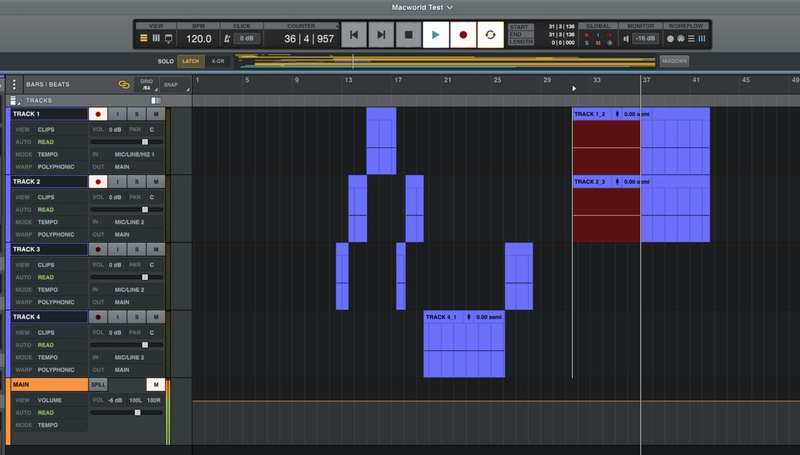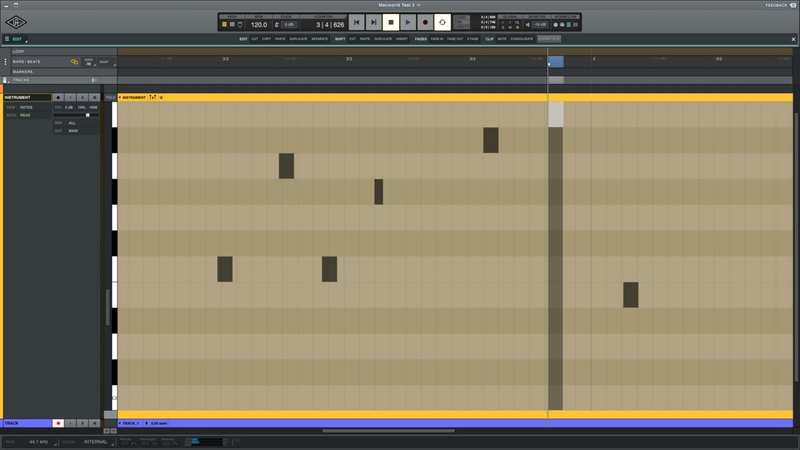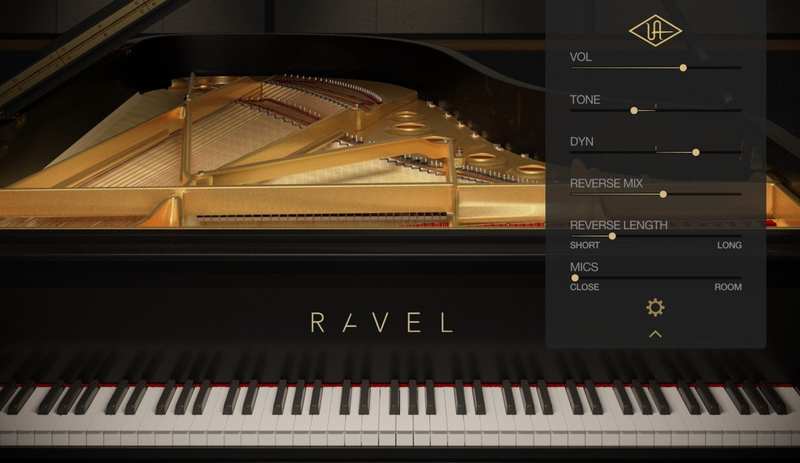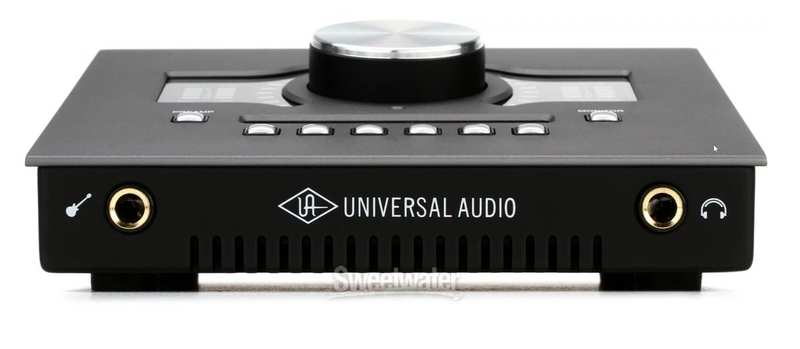Universal Audio Luna 评论:留意 Logic 和 Pro Tools,Luna 诗篇来了
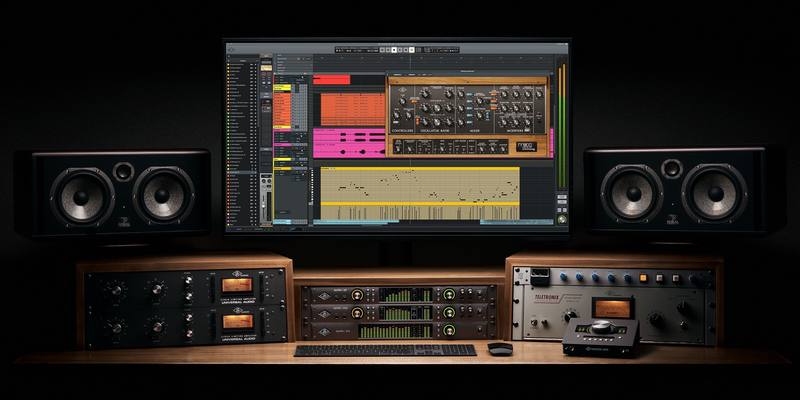
At a Glance
Expert’s Rating
Pros
- Tight integration with UA Thunderbolt audio interfaces (required) and DSP plug-ins
- Infinite undo and redo across sessions
- Free if you own the proper hardware.
Cons
- Immature interface and feature set
- No support for third-party hardware of any kind
Our Verdict
Luna’s excellent infrastructure, and proposed scope warrant more than 3.5 stars, but the DAW is still in its infancy and even the basics are still being fleshed out. It also works only with Universal Audio’s Thunderbolt audio interfaces. For existing users, it’s usable now, as well as a tantalizing look at the future. Others should wait a couple of iterations till UA’s rival to Pro Tools matures.
Universal Audio’s new Luna Recording System is a digital audio workstation (DAW) aimed squarely at anyone who digs the analog vibe and tape recorder/mixing console workflow. Actually, in this case, a digital emulation thereof—something UA’s Apollo audio interfaces with their on-board DSP processing and plug-in architecture are known for.
The kicker? Luna is free if you already own a UA Thunderbolt interface. If you don’t, the ante is $500 for UA’s entry-level Arrow. Hardly chump change, but if my initial hands-on is any indication, you may be willing to pony up—in due time.
At the moment, there are minor bugs and unimplemented features, though fewer than you might expect for a 1.x program that was released early for a world rife with clamoring shut-ins.
Note: There’s a lot of discussion in this article about UA’s hardware-only plug-in architecture. As of 3/30/2022, the company’s new Spark service allows users to access these highly-rated plug-ins running natively on the Mac. $20 per month.
Under the hood
I spent about 15 minutes luxuriating in Luna’s new-car smell and getting used to the general layout. That was more than enough time for the schematical and operational resemblance to Pro Tools to sink in. Even the keyboard shortcuts are largely the same. It’s not note for note, but the users of Avid’s flagship DAW will feel at home right off the bat.
Universal Audio’s Luna with two windows open showing the two main views: timeline and mixer.
After the break-in period, it was time to delve into some of the impressive stuff going on under the hood. First and foremost there’s the largely seamless melding of the Apollo interface DSP effects with those that are computer-rendered. Formerly, UA’s separate Console application was required to set up the Apollo’s DSP effects on cue mixes (what the artist hears in the headphones) and inputs. Now Luna handles all that so visits to Console are rare.
As a byproduct of this DAW/hardware integration, there’s no configuring of the audio interface. Inputs appear automatically and there’s no buffer size setting. When you create a cue mix it’s actually happening on the interface, and you can even turn the 48 volt phantom power on and off.
Luna allows you to mix sample rates freely, which, while not unique in the DAW world, is completely transparent. The audio engine can re-sample and play anything from 44.1kHz to 192kHz on the fly, while background rendering creates files matching the current project sample rate that will be used eventually to reduce the processing overhead this rate juggling incurs. I tried importing a batch of files from 44.1kHz to 96kHz and there was never a hiccup.
UA’s tape extension plugins.
Luna also features “extensions,” which are proprietary audio and MIDI plug-ins that embed into the mixer. Out of the gate there two audio extensions that mimic the saturated sound of tape: Oxide (generic and included for free) and Studer A800 ($299 if you don’t already own the DSP version); plus another that imitates the bus summing (mixing audio signals from multiple channels) of a Neve 80 series analog mixing desk ($299).
The only MIDI extension in Luna 1.01 is the free ARP arpeggiator. It’s capable and easy to use, but nothing extraordinary. Its existence does, however, point out the potential for further MIDI mayhem.
The sole MIDI extension at Luna launch was the ARP arpeggiator.
You may have noticed that the Neve and Studer extensions cost a fair bit. As noted, they’re also exclusive to Luna, as are the instruments that I’ll cover in a bit. Big tip: If the free stuff won’t do, wait for the frequent UA sales or buy them in discounted bundles. After hearing the Neve summing demo, trust me—the slippery slope of plug-in collecting will be tough to avoid. UA lets you demo them for 14 days. Be strong friends.
While UA’s plug-ins are expensive, Luna allows you to use your third-party AU (Audio Unit) plug-ins. Most of them at any rate; a few of my older instruments wouldn’t load, and at least one newer one wouldn’t make noise. All UA plugins run on the audio interface and are limited by its DSP power.
All audio files are stored in a single package (a folder abstracted to appear as a single file under macOS) with a database tracking them as well as your actions. They’re all saved as a matter of course—there’s no user initiated save function.
Luna stores all MIDI and audio files, as well as settings and a history of actions in a macOS package for easy transfer. Continual save and tracking facilitate infinite undo and redo.
I can’t tell you how much I enjoy the lack of “Save your work?” dialog boxes and infinite undo and redo across sessions. The latter is a handy and highly addictive feature I’ve been pushing on every software vendor I know since I first saw it in the Write! text editor.
Luna also has easy drag-and-drop import of MIDI (songs and tracks), audio (WAV, AIFF, MP3, M4A, Apple Lossless, etc.), and the AAF (Advanced Authoring Format) files that other top pro-level DAWs understand. It exports most of those as well. Getting stems (the contents of individual tracks) in and out is as easy as it gets; given that the feudal DAW industry has yet to develop a combined MIDI/Audio file format.
Interface and navigation
If you’re at all familiar with DAWs such as Apple’s Logic or Avid’s Pro Tools, you won’t be startled by anything you see in Luna. Pleased perhaps, but not surprised. Run the program and there’s the usual timeline with tracks that house audio or MIDI clips. Click on an icon and you have an equally familiar mixing console view with faders, knob, insert slots, etc.
As shown below, you can have multiple alternate windows sporting variations on these two main layouts. The image shows three; you can have more.
Luna allows multiple “alternate” windows showing variations on the timeline or mixer layout. A nice take on screen sets or multi-view.
While not revolutionary, Luna’s layout is logically organized, allows you to show or hide just about everything, and the graphic designers somehow managed to marry skeuomorphism and 2D modernity in an agreeable fashion. Tastes vary, but I like the look.
That said, there’s quite a bit of tiny, low-contrast text. The interface doesn’t scale, so I had to crank my display’s brightness and run at 2048×1152 on my 27-inch 5K iMac. Sharper eyes probably won’t care.
This is a basic Luna timeline layout. On top are the transport and main options, as well as one version of the drop-down “workflow” menu. Below are the focus browser, focus channel strip, track headers and timeline, and monitor strip.
From left to right, the timeline window contains a “Focus browser” where you’ll find instruments, presets, track lists (show/hide) and options pertaining to the current task or object; a “Focus channel” mixer strip for the currently selected track; track headers that contain the arm, solo, mute buttons, etc.; the timeline/track display with rulers for beats, time, samples, tempo, time signatures, and markers; and a mixer strip for the monitor mix.
The basic Luna mixer layout. UA uses the Power, Remove, Copy/paste, and Set default “modifiers” to configure the mixer strips en masse.
The mixer is the aforementioned classic design,with slots divided into areas for Luna instruments; Unison (see The UA Ecosystem below) effects; as well standard inserts for other DSP and AU effects. Various items on the mixer can be shown or hidden, and strips can be grouped for wholesale changes. The Power, Remove, Copy (paste), and Set default buttons to the left of the mixer strips are “modifiers” that let you easily perform detailed configuration of multiple tracks.
At the top of both the timeline and mixer windows are the transport console/display section that hides drop-down “Workflow” menus providing editing, MIDI, recording, and mixing options/commands. There’s also the UA logo at the upper left which you click on to see advertising, the extension/instrument store, and change settings. You can hide any of the panes or rulers I’ve described except the transport, the timeline and mixer in their respective views, and the bars and beats ruler.
Luna’s transport/control bar has the usual playback functions but also controls layout configuration.
As I said, I like the look, but as of this writing there’s an abundance of oddities, inconsistencies, and omissions. Several that jumped out immediately were the timeline not scrolling to keep up with the song; the lack of keyboard shortcuts to show/hide screen elements; and the right mouse button at times invoking a context menu (not nearly often enough), and other times mimicking the left button.
Recording
Recording was a breeze, and rock solid. You can kick in and out of record mode at will while playing and doing other work without dropouts. Luna allows multiple versions of whole tracks, à la Logic, as well as classic “takes” generated from loop recording. Comping, i.e., taking the best bits from multiple takes is a tad tedious, forcing you to copy and paste to the “comp” take. There are currently no take lanes as with Logic or splitting a clip and scrolling through takes as in Ableton Live.
Recording with Luna. If you loop record, takes are added, otherwise recording over an existing clip merely sends it to the back.
Latency (the time from playing to hearing through the speakers) with Luna and the Apollo Twin X Quad that UA loaned me was minimal with ARM (Accelerated Realtime Monitoring) enabled, but I didn’t stack plugins on the input channel or cue mix as some do. I used only pre-amps with microphones and amp sims with guitars, and latency was certainly low enough to sing or play to.
One very nice touch: when you finish a looped recording, the last partial take is discarded if there’s nothing meaningful in it.
Editing
All editing in Luna is done inline on the tracks, directly to, or within the clips. Nearly all operations can be performed on multiple objects as well. The cursor changes appearance to let you know what actions are possible at the current location. For example, it becomes a half bracket in the lower corners where you can change the start/end points of the clip. If you’re not familiar with clips, think of them as movable windows that display, play, and affect only a portion of a MIDI/audio file.
Gain and pitch tranpose controls are available directly on audio clips but not MIDI clips.
There’s a keyboard shortcut (“e”) to expand clips to the full size of the visible timeline, so you won’t miss a dedicated editor much, if at all. Automation can be edited either on top of the content, or in its own lane below.
MIDI editing can be destructive—you can change the actual contents of a MIDI clip, however, as with programs such as Ableton Live, audio editing is non-destructive. Instead, you alter the playback properties of clips such as start and end points, gain or pitch, and fades.
Editing a MIDI clip enlarged to fit the entire visible timeline in Luna
I found audio editing very straightforward and quick, and I like being able to adjust the pitch and gain right on the clip header. The exception was editing (moving, squeezing, or elongating notes) using Luna’s audio stretch/warp modes, of which there are six. Adding the warp markers is a breeze, but accurately moving them to the desired location was a bit difficult becasue the ruler ticks and alignment grid are difficult to see. How difficult varied with the color of the clip. See below.
Audio stretching and warping is laughably easy, if you have eyesight keen enough to see the faint grid lines.
Basic MIDI editing, such as changing location, duration, pitch, velocity, muting, etc. is also a pushover. But you can’t transpose the pitch of MIDI clips as you can audio clips, and there’s no stretching or compressing of notes in time to create tuplets, accellerandos or retardandos, etc.
Applying quantization (snapping notes to the grid) requires mousing to the focus panel, rather than a pop-up. Which brings me to my other observation about the Luna interface—it regularly forces your eye and cursor to the side (focus browser) and top (workflow menu) of the workspace rather than placing functionality where the user is currently focused. Do your eyes and hands a favor and learn the keyboard shortcuts ASAP.
Instruments
UA has not only jumped feet first into the DAW market, it’s entered into another related segment—virtual instruments. The included Shape features a remarkably high-quality set of sampled instruments; 10GB worth of keyboards, brass, strings and other stuff that all sounds great. UA is only the curator for many of the sounds, which are licensed from highly-rate vendors such as Spitfire and Orange Tree.
Universal Audio’s Ravel piano instrument is a very nice sampling of a Steinway B.
But this wouldn’t be UA if there weren’t pay options: Ravel, a splendid Steinway “B” grand piano, and Moog, a very nice rendition of the famous monophonic synth from the 70’s. Both sound excellent, but are $300 a pop and as with extensions, proprietary to Luna. You’ll also find Spitfire symphonic instruments in the Luna in-app store.
Note that while it’s not an issue for Luna’s first generation Shape, Ravel, and Moog, there’s currently no support for instruments with multiple audio outputs such as EZ Drummer or Kontakt. You’ll need to use multiple tracks and instances of the instruments as a workaround.
The UA ecosystem
Luna is irrevocably entwined with UA’s Apollo Thunderbolt interfaces, which feature anywhere from 1 to 6 DSPs (Digital Signal Processors) that run proprietary plug-ins, for recording or mix-down. How the Apollos sound is obviously key to whether you’ll even want to consider Luna. Short answer: UA isn’t stupid—they sound great.
The aforementioned $1,399 Thunderbolt 2 Twin X Quad and its four DSPs impressed me with clean, virtually noise-free pre-amps and stellar output. But you can get that for a lot less. It’s the DSP Unison plug-ins that “…adjust the physical input impedance, gain staging response, and other parameters…” to mimic classic hardware that sets Apollos apart.
Universal Audio’s TwinX Duo audio interface. With two DSPs and two inputs (the Hi-Z interrupts one of the mic inputs), it allows tracking two instruments or processing two channels during mixdown. More inputs can be added via ADAT.
The Twin X interface ships with a bundle of useful, low-latency DSP-based plug-ins (Unison and not), ranging from famous channel strips, to reverb and compressors, and they all sound very good. If the free stuff doesn’t do the trick, there’s also a huge variety of pay-to-play offerings. I demo’d a ton of them and each proved sonically superior.
I was particularly impressed by the Ampeg B15 bass amp and Marshall guitar amp simulations and how responsive they were when I plugged into the high impedance (Hi-Z) input. With a Rode 1a and various other microphones, the pre-amp emulations rocked as well. There is a bit more input latency than with other interfaces due to the processing, however, it’s not debilitating.
I’ll leave the debate as to the quality or value of UA’s interfaces and plug-ins versus other vendor’s efforts to the forums—there’s a lot of very good stuff out there. However, I will say that there’s a very good reason that UA sells a lot of stuff.
The main drawback to the Twin X is that there are only three inputs and you can use only two at a time. UA, as with other vendors, lists the number of inputs and outputs (10/6 in this case) the interface can handle if you expand it with an ADAT preamp module.
But there’s also the aforementioned DSP-only nature of the addictive UA plug-ins. There’s a chart at the UA website that tells you what percentage of the DSP’s juice is used by each plug-in at 44.1kHz. Multiply by how many you’ll use to determine how many DSPs and which interface you’ll need.
Note that UA doesn’t supply Thunderbolt cables with any of its interfaces. If you’re buying new, add one to the order, or seek a vendor that includes one for free.
Enticing, but not for everyone
I’m incredibly impressed with Luna and its potential, but here’s a quick dose/recap of the considerations.
- Luna requires a Universal Audio Thunderbolt audio interface and other brands of interfaces can’t be used in conjunction (ADAT preamps excluded).
- Luna’s extensions and instruments are proprietary and require iLok (account or dongle).
- All UA plug-ins are DSP-only and limited by its power.
- Luna doesn’t currently support hardware controllers of any type. Push, Roli, mixing consoles, etc.
- There’s no support for using interface I/O to loop in external hardware effects. (hardware inserts)
- Only the more recent Mojave and Catalina versions of macOS are supported, though some have reported success on High Sierra. I tried it, I had issues.
Luna isn’t even for all UA owners, many of whom use Windows. A version for that OS has been hinted at, but not promised. USB Apollo interface owners are out of luck as well, as UA has said it needs the capabilities of Thunderbolt to perform Luna magic.
Additionally, Luna is singularly focused on recording and basic editing. Outside of the ARP arpeggiator extension, there are no features for those that like to dabble with beat, note, or sound creation. There’s no side-chaining either, which is a huge deal for EDM (Electronic Dance Music) types.
I’ve already mentioned cost several times, and UA hardware and plug-ins are indeed pricey by struggling musician—excuse me, frugal artist—standards. However, $10,000 for a 16-channel Apollo setup with all the trimmings, i.e., all the DSP plug-ins, or around $6,000 for just the hardware and bundled plug-ins that includes Luna is pretty reasonable for the audio heart of a small studio. It’s sure as heck a lot cheaper than buying all the hardware it will emulate.
If the $1,399 price tag of the Quad is a bit much for you, the Twin X Duo has the same preamps and AD/DA with half the DSP power for $899, and would llikely have done just as well in my low-stress tests. The X4 has four preamps for $1,799. If I were going UA, I’d opt for the latter, or step up to one of the rack mounts to be sure I never ran short on DSP.
A stellar job so far, but a tough decision
Kudos to Universal Audio for releasing a largely stable, keenly-focused DAW with fantastic sounding plugins and instruments. It’s highly functional right out of the gate, if not feature-complete. Additional praise for letting it out into the world early so bored shut-ins can play with it. UA users will no doubt enjoy the experience.
Outsiders contemplating a move to the UA/Luna-verse should probably hold off for at least a couple of months until the company has ironed out the wrinkles. Unless of course, you’re intensely curious and have the bucks to scratch the itch. At the very least, those bucks will buy you some extremely capable, aurally pleasing hardware and plug-ins.
Luna is a shipping product, so it gets a rating based on its current state and suitability to task compared to similar products. There are just a few too many gaps to ignore, however—yes, no good deed (the early release) goes unpunished. But it’s not hard to imagine Luna getting better when development is a bit further along.
As there’s no way to preview Luna without UA hardware, you can check out the documentation here.
8/8/2020 As of version 1.08, Luna now supports auto-scrolling which ameliorates one of my complaints. Also, a long-time Logic themer is now delivering alternative looks for Luna. This may address some of my complaints about sometimes inadequate contrast.
10/6/202 Version 1.1 adds a number of features including track groups, drag MIDI from virtual instruments to the tracks, and MIDI clock output.

